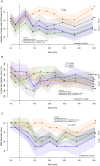Reversal of mecamylamine-induced effects in healthy subjects by nicotine receptor agonists: Cognitive and (electro) physiological responses
- PMID: 29319910
- PMCID: PMC5903244
- DOI: 10.1111/bcp.13507
Reversal of mecamylamine-induced effects in healthy subjects by nicotine receptor agonists: Cognitive and (electro) physiological responses
Abstract
Aims: Establishing a pharmacological challenge model could yield an important tool to understand the complex role of the nicotinic cholinergic system in cognition and to develop novel compounds acting on the nicotinic acetylcholine receptor.
Methods: This randomized, double-blind, double-dummy, placebo-controlled, four-way crossover study examined the effects of the nicotinic antagonist mecamylamine on a battery of cognitive and neurophysiological test with coadministration of a placebo, nicotine or galantamine in order to reverse the cognitive impairment caused by mecamylamine.
Results: Thirty-three healthy subjects received a single oral dose of 30 mg of mecamylamine (or placebo) in combination with either 16 mg of oral galantamine or 21 mg of transdermal nicotine (or its double-dummy). Mecamylamine 30 mg induced significant disturbances of cognitive functions. Attention and execution of visual (fine) motor tasks was decreased, short- and long-term memory was impaired and the reaction velocity during the test was slower when compared to placebo. Mecamylamine 30 mg produced a decrease in posterior α and β power in the surface electroencephalogram, effects that were reversed by nicotine coadministration. Memory and motor coordination tests could be partially reversed by the coadministration of nicotine.
Conclusions: Mecamylamine administration induced slowing of the electroencephalogram and produced decrease in performance of tests evaluating motor coordination, sustained attention and short- and long-term memory. These effects could be partially reversed by the coadministration of nicotine, and to a lesser extent by galantamine.
Keywords: clinical pharmacology; cognitive impairment reversal; healthy subjects; mecamylamine; neuropharmacology; nicotine; pharmacodynamic effects.
© 2018 The British Pharmacological Society.
Figures



Similar articles
-
An EEG nicotinic acetylcholine index to assess the efficacy of pro-cognitive compounds.Clin Neurophysiol. 2018 Nov;129(11):2325-2332. doi: 10.1016/j.clinph.2018.08.014. Epub 2018 Sep 11. Clin Neurophysiol. 2018. PMID: 30248622 Clinical Trial.
-
An anti-nicotinic cognitive challenge model using mecamylamine in comparison with the anti-muscarinic cognitive challenge using scopolamine.Br J Clin Pharmacol. 2017 Aug;83(8):1676-1687. doi: 10.1111/bcp.13268. Epub 2017 Apr 8. Br J Clin Pharmacol. 2017. PMID: 28217868 Free PMC article. Clinical Trial.
-
Pharmacokinetics and pharmacodynamics of oral mecamylamine - development of a nicotinic acetylcholine receptor antagonist cognitive challenge test using modelling and simulation.J Psychopharmacol. 2017 Feb;31(2):192-203. doi: 10.1177/0269881116681417. Epub 2016 Dec 9. J Psychopharmacol. 2017. PMID: 27927703
-
Nicotinic receptor subtypes and cognitive function.J Neurobiol. 2002 Dec;53(4):633-40. doi: 10.1002/neu.10151. J Neurobiol. 2002. PMID: 12436426 Review.
-
Green tobacco sickness: mecamylamine, varenicline, and nicotine vaccine as clinical research tools and potential therapeutics.Expert Rev Clin Pharmacol. 2019 Mar;12(3):189-195. doi: 10.1080/17512433.2019.1570844. Epub 2019 Jan 24. Expert Rev Clin Pharmacol. 2019. PMID: 30650314 Free PMC article. Review.
Cited by
-
The Basal Forebrain Cholinergic Nuclei and Their Relevance to Schizophrenia and Other Psychotic Disorders.Front Psychiatry. 2022 Jul 6;13:909961. doi: 10.3389/fpsyt.2022.909961. eCollection 2022. Front Psychiatry. 2022. PMID: 35873225 Free PMC article. Review.
-
Galantamine-memantine combination superior to donepezil-memantine combination in Alzheimer's disease: critical dissection with an emphasis on kynurenic acid and mismatch negativity.J Geriatr Care Res. 2018;5(2):57-67. J Geriatr Care Res. 2018. PMID: 30984874 Free PMC article.
-
Safety, pharmacokinetics and exploratory pro-cognitive effects of HTL0018318, a selective M1 receptor agonist, in healthy younger adult and elderly subjects: a multiple ascending dose study.Alzheimers Res Ther. 2021 Apr 21;13(1):87. doi: 10.1186/s13195-021-00816-5. Alzheimers Res Ther. 2021. PMID: 33883008 Free PMC article. Clinical Trial.
-
Neurochemistry of Visual Attention.Front Neurosci. 2021 May 5;15:643597. doi: 10.3389/fnins.2021.643597. eCollection 2021. Front Neurosci. 2021. PMID: 34025339 Free PMC article. Review.
References
-
- Jones S, Sudweeks S, Yakel JL. Nicotinic receptors in the brain: correlating physiology with function. Trends Neurosci 1999; 22: 555–561. - PubMed
-
- Levin ED, McClernon FJ, Rezvani AH. Nicotinic effects on cognitive function: behavioral characterization, pharmacological specification, and anatomic localization. Psychopharmacology (Berl) 2006; 184: 523–539. - PubMed
-
- Court J, Piggott M, Lloyd S, Cookson N, Ballard C, McKeith I, et al Nicotine binding in human striatum: elevation in schizophrenia and reductions in dementia with Lewy bodies, Parkinson's disease and Alzheimer's disease and in relation to neuroleptic medication. Neuroscience 2000; 98: 79–87. - PubMed
-
- Parri HR, Hernandez CM, Dineley KT. Research update: alpha7 nicotinic acetylcholine receptor mechanisms in Alzheimer's disease. Biochem Pharmacol 2011; 82: 931–942. - PubMed
-
- Ebert U, Kirch W. Scopolamine model of dementia: electroencephalogram findings and cognitive performance. Eur J Clin Invest 1998; 28: 944–949. - PubMed
Publication types
MeSH terms
Substances
LinkOut - more resources
Full Text Sources
Other Literature Sources

